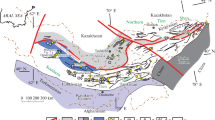Abstract
Laser fusion 40Ar/39Ar ages of titanian pargasite from a microgranodiorite dyke swarm in the southern Bohemian Massif effectively date the early Permian (late Autunian) emplacement of dykes into a cool Moldanubian crust. This intrusion represents the youngest magmatic phase recorded in this part of the Moldanubian Zone. Strontium and neodymium isotopic ratios of microgranodiorites point to magma derivation from re-melting the lower crustal rocks with a possible component of upper mantle composition. Spatial and temporal association of the dykes with movements on a major N–S (NNE–SSW) tectonic discontinuity (Blanice–Kaplice–Rödl fault zone) suggests that their emplacement corresponds to the maximum age of fault movements associated with the E/W-oriented extension in this part of the Bohemian Massif.
Similar content being viewed by others
Author information
Authors and Affiliations
Additional information
Electronic Publication
Rights and permissions
About this article
Cite this article
Košler, J., Kelley, S. & Vrána, S. 40Ar/39Ar hornblende dating of a microgranodiorite dyke: implications for early Permian extension in the Moldanubian Zone of the Bohemian Massif. Int J Earth Sci 90, 379–385 (2001). https://doi.org/10.1007/s005310000154
Received:
Accepted:
Published:
Issue Date:
DOI: https://doi.org/10.1007/s005310000154




